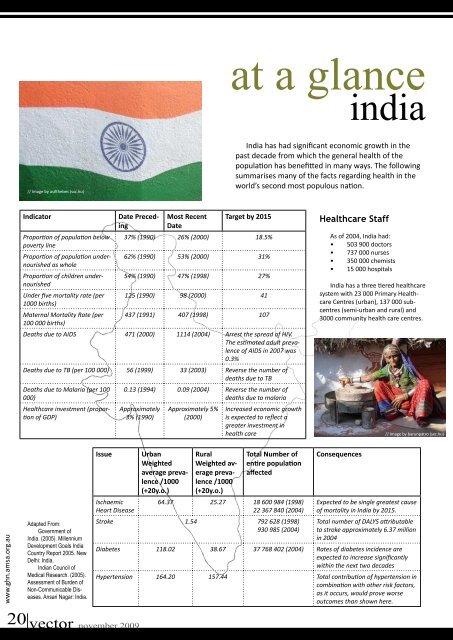Create successful ePaper yourself
Turn your PDF publications into a flip-book with our unique Google optimized e-Paper software.
at a glance<br />
india<br />
// Image by asifthebes (sxc.hu)<br />
India has had significant economic growth in the<br />
past decade from which the general health of the<br />
population has benefitted in many ways. The following<br />
summarises many of the facts regarding health in the<br />
world’s second most populous nation.<br />
Indicator<br />
Date Preceding<br />
Most Recent<br />
Date<br />
Target by 2015<br />
Proportion of population below 37% (1990) 26% (2000) 18.5%<br />
poverty line<br />
Proportion of population undernourished<br />
62% (1990) 53% (2000) 31%<br />
as whole<br />
Proportion of children undernourished<br />
54% (1990) 47% (1998) 27%<br />
Under five mortality rate (per 125 (1990) 98 (2000) 41<br />
<strong>10</strong>00 births)<br />
Maternal Mortality Rate (per 437 (1991) 407 (1998) <strong>10</strong>7<br />
<strong>10</strong>0 000 births)<br />
Deaths due to AIDS 471 (2000) 1114 (2004) Arrest the spread of HIV.<br />
The estimated adult prevalence<br />
of AIDS in 2007 was<br />
0.3%<br />
Deaths due to TB (per <strong>10</strong>0 000) 56 (1999) 33 (2003) Reverse the number of<br />
deaths due to TB<br />
Deaths due to Malaria (per <strong>10</strong>0<br />
000)<br />
Healthcare investment (proportion<br />
of GDP)<br />
0.13 (1994) 0.09 (2004) Reverse the number of<br />
deaths due to malaria<br />
Approximately<br />
3% (1990)<br />
Approximately 5%<br />
(2000)<br />
Increased economic growth<br />
is expected to reflect a<br />
greater investment in<br />
health care<br />
Healthcare Staff<br />
As of 2004, India had:<br />
• 503 900 doctors<br />
• 737 000 nurses<br />
• 350 000 chemists<br />
• 15 000 hospitals<br />
India has a three tiered healthcare<br />
system with 23 000 Primary Healthcare<br />
Centres (urban), 137 000 subcentres<br />
(semi-urban and rural) and<br />
3000 community health care centres.<br />
// Image by barunpatro (sxc.hu)<br />
www.ghn.amsa.org.au<br />
Adapted From:<br />
Government of<br />
India. (2005). Millennium<br />
Development Goals India<br />
Country Report 2005. New<br />
Delhi: India.<br />
Indian Council of<br />
Medical Research. (2005).<br />
Assessment of Burden of<br />
Non-Communicable Diseases.<br />
Ansari Nagar: India.<br />
<strong>Issue</strong><br />
Ischaemic<br />
Heart Disease<br />
Urban<br />
Weighted<br />
average prevalence<br />
/<strong>10</strong>00<br />
(+20y.o.)<br />
Rural<br />
Weighted average<br />
prevalence<br />
/<strong>10</strong>00<br />
(+20y.o.)<br />
Total Number of<br />
entire population<br />
affected<br />
64.37 25.27 18 600 984 (1998)<br />
22 367 840 (2004)<br />
Stroke 1.54 792 628 (1998)<br />
930 985 (2004)<br />
Consequences<br />
Expected to be single greatest cause<br />
of mortality in India by 2015.<br />
Total number of DALYS attributable<br />
to stroke approximately 6.37 million<br />
in 2004<br />
Diabetes 118.02 38.67 37 768 402 (2004) Rates of diabetes incidence are<br />
expected to increase significantly<br />
within the next two decades<br />
Hypertension 164.20 157.44 Total contribution of hypertension in<br />
combination with other risk factors,<br />
as it occurs, would prove worse<br />
outcomes than shown here.<br />
20 vector november <strong>2009</strong>
















